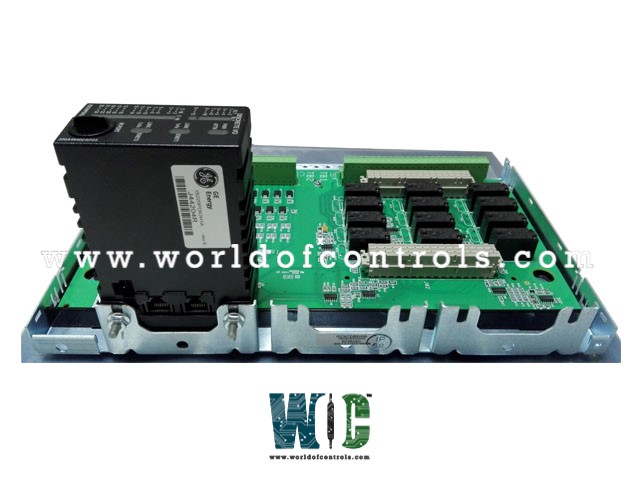
World Of Controls understands the criticality of your requirement and works towards reducing the lead time as much as possible.
IS230TDBTH2A - Discrete Input/Output Terminal Board is available in stock which ships the same day.
IS230TDBTH2A - Discrete Input/Output Terminal Board comes in UNUSED as well as REBUILT condition.
To avail our best deals for IS230TDBTH2A - Discrete Input/Output Terminal Board, contact us and we will get back to you within 24 hours.
SPECIFICATIONS:
Part Number: IS230TDBTH2A
Manufacturer: General Electric
Series: Mark VIe
Product Type: Discrete Input/Output Terminal Board
Number of Channels: 24
Wetting voltage: 24 V dc
Input current: 24 V dc
Input filter: 4 ms
Technology: Surface mounting
Operating temperature: -30 to 65°C
Size: 17.8 cm wide x 33.02 cm
Repair: 3-7 Day
Availability: In Stock
Weight: 2 lbs
Country of Origin: United States
Manual: GEH-6721L
FUNCTIONAL DESCRIPTION:
IS230TDBTH2A is a Discrete Input/Output Terminal Board manufactured and designed by General Electric as part of the Mark VIe Series used in GE Distributed Control Systems. The Discrete Input/Output (TDBT) terminal board is a TMR contact input/output terminal board designed for DIN-rail or flat mounting. The TDBT board accepts 24 group isolated contact inputs that are supplied with a nominal 24, 48, or 125 V dc wetting voltage from an external source. The contact inputs have noise suppression to protect against surge and high-frequency noise. TDBT provides 12 form-C relay outputs and accepts an option card to expand relay functions. In Mark* VIe systems, the PDIO I/O pack works with the TDBT. Three I/O packs plug into D-type connectors and communicate with the controllers over Ethernet. Three connection points for PDIO are provided. With dual controllers, the PDIO on TDBT connector JR1 would be networked to the R controller, JS1 PDIO to the S controller, and JT1 PDIO to both R and S controllers. With TMR controllers one network connection is provided to each PDIO leading to the respective controller. TDBT is not designed to operate correctly with a single PDIO I/O pack.
INSTALLATION:
The TDBT plus a plastic insulator mounts on a sheet metal carrier that then mounts on a DIN rail. Optionally the TDBT plus insulator mounts on a sheet metal assembly that then bolts in a cabinet. The connections are wired directly to two sets of 48 terminal blocks, typically using #18 AWG wires. The upper set of terminals, TB1, connects to the relay portion of the board and the lower set of terminals, TB2, connects to the contact input circuits. Screw assignments for the two sets of terminals are identical to those found on the SRLY relay board and the STCI contact input terminal board. Shields should be terminated on a separate bracket.
OPERATION:
The contact input function and on-board signal conditioning are the same as those on STCI, they are scaled for 24, 48, and 125 V dc wetting voltage. The input wetting voltage range is 16 to 32 V dc, 32 to 64 V dc, and 100 to 145 V dc respectively. The threshold voltage is 50% of the wetting voltage. The contact sensing circuits are shown in the I/O pack description. Contact input currents are resistance limited to 2.5 mA on the first 21 circuits, and 10 mA on circuits 22 through 24. The 24 V dc supply on TDBTH2 is currently limited to 0.5 A using polymer positive temperature coefficient fuses that can be reset. Filters reduce high-frequency noise and suppress surge on each input near the point of signal entry. The discrete input voltage signals go to the I/O processor which passes them through optical isolators, converts them to digital signals, and transfers them to the controller.
WOC has the largest stock of OEM replacement parts for GE Distributed Control Systems. We can also repair your faulty boards and supply unused and rebuilt boards backed up with a warranty. Our team of experts is available round the clock to support your OEM needs. Our team of experts at WOC is happy to assist you with any of your automation requirements. For pricing and availability on parts and repairs, kindly contact our team by phone or email.
What is a discrete input/output terminal board?
A discrete input/output terminal board is a device used in electronic systems to interface between digital signals (usually represented as discrete on/off or high/low states) and the external world. It typically provides terminals or connectors for connecting digital input and output signals from sensors, switches, actuators, or other devices.
What are the main components of a discrete input/output terminal board?
The main components typically include input terminals for receiving digital signals from external devices, output terminals for sending digital signals to external devices, signal conditioning circuitry (such as voltage or current level shifting), protection components (such as diodes or transient voltage suppressors), and interfacing electronics (such as buffers or drivers).
What are the applications of discrete input/output terminal boards?
These boards are used in various applications where digital signals need to be interfaced with a control system or microcontroller. Common applications include industrial automation, process control, home automation, robotics, automotive systems, and embedded electronics projects.